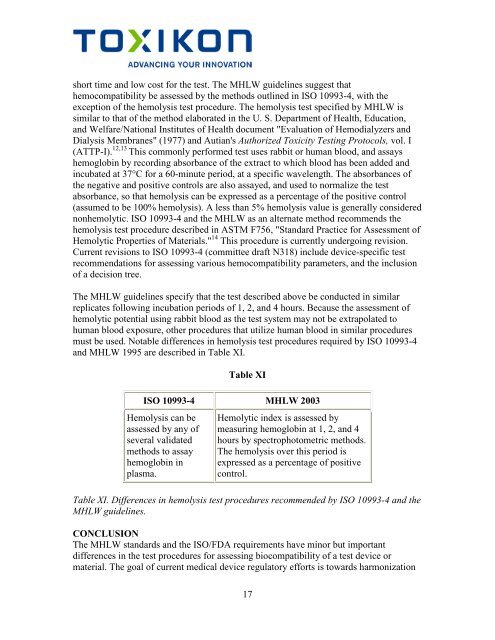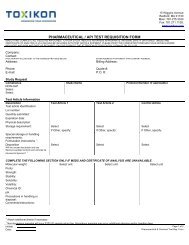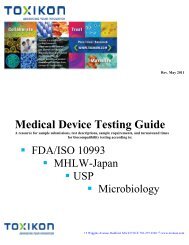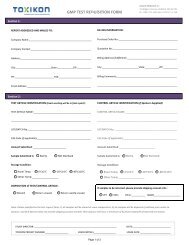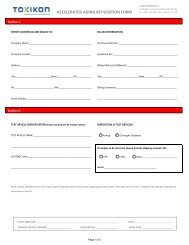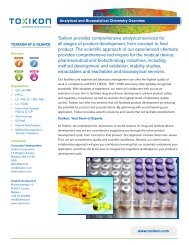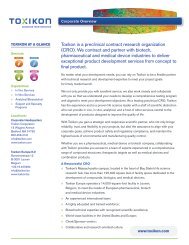Biocompatibility Safety Assessment of Medical Devices ... - Toxikon
Biocompatibility Safety Assessment of Medical Devices ... - Toxikon
Biocompatibility Safety Assessment of Medical Devices ... - Toxikon
You also want an ePaper? Increase the reach of your titles
YUMPU automatically turns print PDFs into web optimized ePapers that Google loves.
short time and low cost for the test. The MHLW guidelines suggest that<br />
hemocompatibility be assessed by the methods outlined in ISO 10993-4, with the<br />
exception <strong>of</strong> the hemolysis test procedure. The hemolysis test specified by MHLW is<br />
similar to that <strong>of</strong> the method elaborated in the U. S. Department <strong>of</strong> Health, Education,<br />
and Welfare/National Institutes <strong>of</strong> Health document "Evaluation <strong>of</strong> Hemodialyzers and<br />
Dialysis Membranes" (1977) and Autian's Authorized Toxicity Testing Protocols, vol. I<br />
(ATTP-I). 12,13 This commonly performed test uses rabbit or human blood, and assays<br />
hemoglobin by recording absorbance <strong>of</strong> the extract to which blood has been added and<br />
incubated at 37°C for a 60-minute period, at a specific wavelength. The absorbances <strong>of</strong><br />
the negative and positive controls are also assayed, and used to normalize the test<br />
absorbance, so that hemolysis can be expressed as a percentage <strong>of</strong> the positive control<br />
(assumed to be 100% hemolysis). A less than 5% hemolysis value is generally considered<br />
nonhemolytic. ISO 10993-4 and the MHLW as an alternate method recommends the<br />
hemolysis test procedure described in ASTM F756, "Standard Practice for <strong>Assessment</strong> <strong>of</strong><br />
Hemolytic Properties <strong>of</strong> Materials." 14 This procedure is currently undergoing revision.<br />
Current revisions to ISO 10993-4 (committee draft N318) include device-specific test<br />
recommendations for assessing various hemocompatibility parameters, and the inclusion<br />
<strong>of</strong> a decision tree.<br />
The MHLW guidelines specify that the test described above be conducted in similar<br />
replicates following incubation periods <strong>of</strong> 1, 2, and 4 hours. Because the assessment <strong>of</strong><br />
hemolytic potential using rabbit blood as the test system may not be extrapolated to<br />
human blood exposure, other procedures that utilize human blood in similar procedures<br />
must be used. Notable differences in hemolysis test procedures required by ISO 10993-4<br />
and MHLW 1995 are described in Table XI.<br />
Table XI<br />
ISO 10993-4 MHLW 2003<br />
Hemolysis can be<br />
assessed by any <strong>of</strong><br />
several validated<br />
methods to assay<br />
hemoglobin in<br />
plasma.<br />
Hemolytic index is assessed by<br />
measuring hemoglobin at 1, 2, and 4<br />
hours by spectrophotometric methods.<br />
The hemolysis over this period is<br />
expressed as a percentage <strong>of</strong> positive<br />
control.<br />
Table XI. Differences in hemolysis test procedures recommended by ISO 10993-4 and the<br />
MHLW guidelines.<br />
CONCLUSION<br />
The MHLW standards and the ISO/FDA requirements have minor but important<br />
differences in the test procedures for assessing biocompatibility <strong>of</strong> a test device or<br />
material. The goal <strong>of</strong> current medical device regulatory efforts is towards harmonization<br />
17


